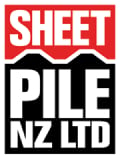- Check soil conditions from soil test logs to determine how hard or soft the soil is expected to be. If the ground is too hard to drive piles, the job may require shorter piles or pre-drilling of the harder ground prior to starting. Do not overdrive/force piles in hard conditions as damage can occur. Especially for challenging jobs, drive a ‘test pile’ to simulate the piles can be driven to the target depth with the selected Vibro Head.
- Selection of the Vibro Head should be based around a number of factors, namely crane size, radius, and line pull.
- The amplitude and frequency should be considered in conjunction with the bore logs and surrounding structures (buildings).
- The weight of the pile vs the hammer weight – a good rule of thumb is that the hammer is 50% heavier than the pile to be driven.
- Excessive hammer size in relation to the pile weight and gauge will significantly increase the risk of pile damage.
- Check the condition of the sheet piles. Work only with undamaged sheets. Inspect the piles for excessive ‘camber’ or ‘sweep’. Check the interlocks are clear of any soil, gravel and debris.
- The head of a bolt should be tack welded over the clutch opening on the leading edge of the sheet at the base to help stop soil getting jammed in the clutch while driving. This will keep it clean for threading of the next pile to be driven.
- Refer to our Panel Driving Method web page for guidelines using a Template and Waler system. A good Template system will aid in keeping sheet piles plumb. It reduces the chance of damage to clutches and leads to good wall construction.
- Drive the first two sheets carefully, checking for vertical, longitudinal and lateral alignment. Taking your time with the initial setup process will greatly assist your installation going forward.
- Check the crane has enough height to clutch the next pile when the previous pile is still mostly in the air. A rule of thumb is twice the length of the piles being installed. Make sure the boom of the crane is ‘luffed’ correctly, directly over the top of the line of the piles to avoid bending the pile you are driving.
- Use a ground release Pile Lifting Clamp to lift a pile into the air and clutch with another pile. Always use the appropriate lifting eyes and pick-up points when handling piles. Trimming 25mm off the top of the clutches will assist in clutching the next sheet and sheets in windy conditions.
- Use a Sheet Pile Threader where piles are being clutched in the air. When a pile is clutched, avoid dropping the pile as it can bend and cause damage. The connecting clutch on the pile being installed should be kept wet with water while the clutch is sliding during installation to avoid overheating the clutches, resulting in clutches ‘welding’ together and causing damage.
- Dense sands can cause piles to distort or refuse to drive. Jetting at the toe of the pile with air or water can assist with advancing further.
- Lifting and lowering the pile multiple times as the penetration becomes slower usually helps. Don’t release all the hammer weight when driving, but rather let the hammer cut/work its way through the ground at a steady pace (faster is not always better).
- Rule of thumb: most hammers have a refusal rate of around 50mm or less of penetration per minute. Should this be encountered, consideration should be given to a larger hammer or jetting as mentioned above.
- If an obstruction is found, keep driving the successive piles until past the obstruction. You can come back later and try driving the obstructed piles again.
- Sheet piles will often ‘creep’ or ‘walk’ at the toe in the direction the wall is being driven. If this occurs, remedy it immediately, even if it takes some time to fix by partially extracting some sheets. It will save damage and time to fix it later.
- An option is to cut the bottom of the pile at 45 degrees from the clutch in the opposite direction you want the top of the pile to lean. (You may need to seek approval to cut the pile).
- NEVER rush the piling foreman/groundsman/pile buck. If it takes longer to install the sheet piles than planned, this will help to reduce the chance of a safety breach, personal Injury or damage to the piles.
Blog
